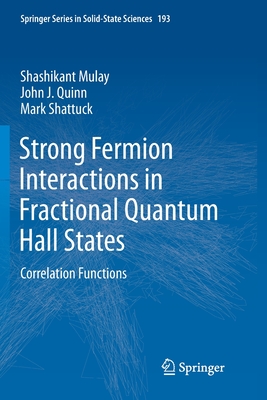$109.99
Usually Ships in 1-5 Days
Description
1. (Chapter 1 Title: Introduction to Quantum Hall States.)Historical background of many-body interactions in the context of integral and fractional quantumHall effect. Review of experimentally observed families of IQL states and their interpretations2. (Chapter 2 Title: The composite Fermion hierarchy and justification of the CF approach.)Jain's mean field composite Fermion picture, Laughlin-Jastrow type correlations. The workof the University of Tennessee group in condensed matter physics justifying MFCF undercertain conditions on the interaction energy. The concept of "Effective CF angular momentum"associated to the lowest CF Landau level. Partially filled shells and Quasi-electons. Haldane'sheirarchy of Laughlin correlated daughter-states and Jain's sequence of IQL states3. (Chapter 3 Title: Correlation diagrams and the Algebra of correlation functions.)Justification of the CF approach. Establishing (with rigorous proofs) conditions under whichJain's elegant CF approach correctly predicts the angular momentum multiplets. Correlationdiagram approach to Moore-Read states provides a new insight and a more general view.Fully symmetric correlation functions for N Fermions in an IQL state for any filing factor lessthan 1/2, obtained from balanced correlation diagrams. Detailed treatment of the algebraiccorrelation functions and diagrams for small values of N; overlap with the numerical workon diagonalization.4. (Chapter 4 Title: Invariant-theoretic essentials.)A self-contained brief introduction to the mathematical theory of invariants of binary formsin context of correlation diagrams and their associated correlation functions. Semi-invariantsof binary forms and dimension counting theorems. The relationship between the semi-invariantsand angular momentum multiplets in presence of quasi-electrons.5. (Chapter 5 Title: Constructions of correlation diagrams and their correlation functions.)Theorems proving existence of nontrivial fully symmetric correlation functions fora class of correlation diagrams. Symmetry groups of the balanced correlation diagramsand their utility from the computational point of view.6. (Chapter 6 Title: Trial wave functions for systems of Fermions in IQL state with generalfilling factor $n / (2 p n + - 1) functions and detailed examination of their special algebraic features.7. (Chapter 7 Title: Correlation functions for some Configurations with quasi-electrons andrelated open questions. ) Concrete constructions of fully symmetric correlation functions forconfigurations of N interacting Fermions some of which are quasi-electrons, for a familytotal angular momenta. Various open mathematical questions directly related to suchconstructions.
About the Author
John J. Quinn is a well-known theoretical physicist as well as an academic administrator; he is a former Chancellor and a professor emeritus since 2015 at the University of Tennessee, Knoxville, USA. He is an expert in the areas of condensed matter physics and many-body theory including two dimensional Composite fermions, low-dimensional systems, quantum Hall effect and nanoscience. Quinn was also one of the first researchers to recognize that physics of 'two-dimensional electron systems' needs to be treated as a professional-sub-specialty. Quinn earned his Ph. D. in Physics in 1958 from the University of Maryland under the supervision of Professor R.A. Ferrell. In 1958, Quinn joined the technical staff at RCA Laboratories. Subsequently, he held visiting positions at the University of Pennsylvania and Purdue University before joining the physics faculty at Brown University in 1965. From 1965 to 1989, Quinn was at Brown University; he held the Ford Foundation Chair in Physics from 1985-1989.From 1989 to 1992, Quinn was the Chancellor of the University of Tennessee, where he has held the Willis Lincoln Chair of Excellence, Professor of Physics and Professor of Engineering Science and Mechanics, from 1992 to 2015. He is a co-author of Solid State Physics (Springer, 2009) with Kyung-Soo Yi. Quinn is a recipient of many honours, including: Fellow, American Physics Society, 1963; NATO Fellow, 1971-1972; ScD Honoris Causa, Purdue University, 1992; Outstanding Graduate Alumnus Award, Physics Department, University of Maryland, 2005; The Distinguished Alumnus Award, College of Computer, Math and Natural Sciences, University of Maryland, 2012.Shashikant B. Mulay is a Professor at the Department of Mathematics, University of Tennessee. Mulay earned his Ph.D. in Mathematics in 1982 from Purdue University under the supervision of Professor Shreeram Abhyankar. His research interests are in Algebra. He has held visiting positions at Purdue University, University of Kentucky, POSTECH (South Korea), MSRI Berkeley and the Max Plank Institute (Germany).Mark A. Shattuck is a Researcher at the Institute for Computational Science, Ton Duc Thang University in Vietnam (2017-present) and an Adjunct Assistant Professor in the Department of Mathematics, University of Tennessee (2013-present). Shattuck earned his Ph.D. in Mathematics in 2005 from the University of Tennessee under the supervision of Professor Carl Wagner. His research interests are primarily in Enumerative and Algebraic Combinatorics. He has been a Visiting Researcher at the University of Haifa (Israel) in 2011-2012 and in 2015.
